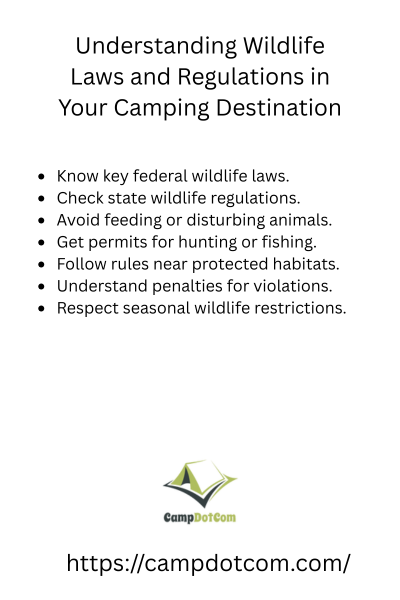If you are anything like me, going on a camping trip means spending real time with nature, and that often includes some amazing wildlife encounters. The important thing to remember is that learning about the wildlife laws and regulations in the place where you camp is not just about following rules. It is about keeping the animals safe, protecting yourself, and caring for the environment. Trust me, I learned this lesson the hard way on a trip last year.
Would you like me to make it a little shorter and more casual, almost like you are chatting with a friend, or keep it at this balanced tone?
Read More About Understanding Wildlife Laws and Regulations in Your Camping Destination

Why Should You Care About Wildlife Laws?
When I first started camping, I thought rules about wildlife were just there to make life harder. Spoiler: they’re not. Those laws are there because animals have their own routines and spaces. Mess with that, and things can get messy fast—for both sides.
As an Amazon Associate, I earn from qualifying purchases. Some of the links in this article are affiliate links. This means that, at zero cost to you, I will earn an affiliate commission if you click through the link and finalize a purchase.
Take my trip to a national park a while back. I saw some people feeding deer near the campsite. I was surprised because I always thought feeding wildlife was harmless. Turns out, it’s a big no-no. Not only can it make animals dependent on humans, but it can also cause aggressive behavior and health problems for the animals. Plus, there are fines involved! Oops.
So, by knowing and respecting these laws, you’re playing a part in keeping the wildlife wild and the camping experience awesome.
More Things to Know About Understanding Wildlife Laws and Regulations in Your Camping Destination

What Kind of Laws Are We Talking About?
Wildlife laws vary depending on where you camp, but here’s the gist:
- Feeding Animals: As I mentioned, it’s usually illegal. Animals need their natural diet, and feeding them human food messes with that balance.
- Keeping Distance: Many places require you to keep a certain distance from wildlife. It’s tempting to get a selfie with a curious fox or a majestic elk, but getting too close stresses the animal and can be dangerous.
- No Harassment: This means no chasing, touching, or trying to lure animals closer.
- Trash Management: Sounds basic, but leaving trash around is a surefire way to attract unwanted critters. Some parks have strict rules about storing food in bear-proof containers or hanging it from trees.
- Hunting and Trapping: Obviously, these are tightly regulated. Even if you’re just passing through, knowing what’s legal and what isn’t helps you stay on the right side of the law.
How to Find Out the Rules Before You Go
Honestly, I used to just wing it, hoping I’d get lucky and not break any rules. Spoiler alert: that’s not the best plan.
Before your trip, spend a few minutes checking the official website for your camping destination. Most national parks, forests, and wildlife refuges have clear sections on wildlife regulations. Some even send out emails or newsletters with seasonal updates. If you’re camping on private land or less-known spots, give the ranger station or local visitor center a quick call.
And don’t forget: laws can change. What was allowed last year might not be this year, especially if animal populations are recovering or if there have been recent problems with human-wildlife conflicts.
What Happens If You Don’t Follow Wildlife Laws?
Besides the obvious (getting a ticket or fine), ignoring these rules can lead to dangerous encounters. I once heard a story about campers who left food out overnight. A curious bear showed up, and the situation quickly got out of hand. Not fun, and definitely avoidable.
Also, some animals can carry diseases or become aggressive if they get too comfortable around humans. That’s bad news for everyone—animals included.
So, even if you don’t care about fines, caring about your safety and the well-being of animals is a good enough reason to follow the rules.
My Personal Wildlife Law Fumble
Let me share a quick story. On a solo camping trip, I didn’t realize that a certain area had a strict “no feeding birds” rule. I thought tossing a few crumbs to some hungry sparrows was harmless. Next thing I knew, a park ranger was politely explaining the rule and why it’s there. I was embarrassed, but also grateful to learn. Since then, I’ve been much more careful about wildlife regulations—because they’re there for a reason.
Tips to Stay Wildlife Law-Savvy on Your Trip
Here’s what I do now:
– Always keep food sealed and stored properly.
– Use binoculars or zoom lenses for close wildlife views instead of approaching.
– Respect signage and ask locals or rangers if unsure.
– Carry a trash bag and pack out everything you bring in.
– Remember that wild animals aren’t pets or photo props.
Respecting Nature Makes Every Camping Trip Better
Camping is such a wonderful way to reconnect with nature, but it also comes with a few responsibilities. Understanding the wildlife laws and regulations in your camping spot isn’t just about following rules, it’s about keeping the balance between adventure and respect. This way, you get to enjoy the beauty of wildlife safely while helping to protect it for others to enjoy too.
Before your next trip, take a quick moment to check out the local wildlife laws. It will give you more confidence, and you may even catch a glimpse of animals acting naturally because of your thoughtful choices.
Do you have a story or a question about wildlife laws? I’d love to hear it!
Happy camping, with respect for nature!
